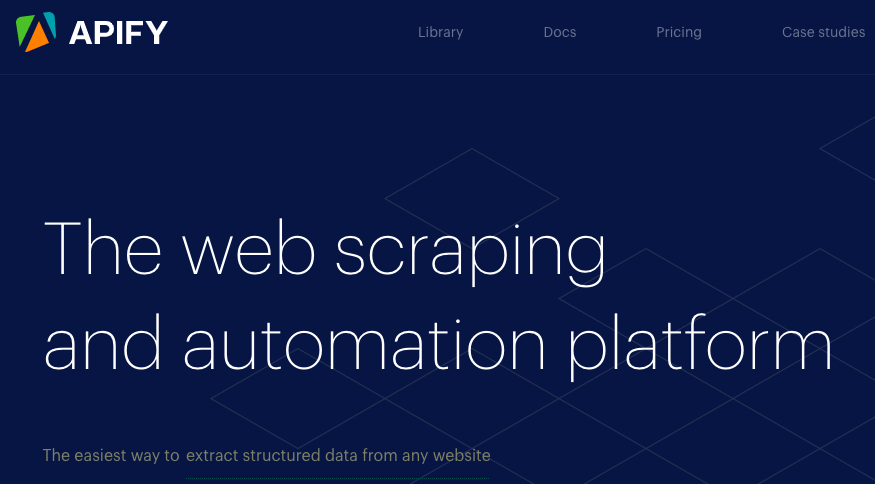
Node.jsでWebクローラーを作成する場合、 requestモジュールとCheerioを使う場合や、ヘッドレスクロームのPuppeteer を使う場合など、複数のパターンがあります。
Puppeteerはスクリーンショットを撮ることができたり、JavaScriptが動作した後のHTMLをクローリングできます。これらは、request+Cheerioでは取得できない内容です。
しかし、Puppeteerはリダイレクトページの取得が難しかったり、動作に多くのメモリが必要となる等の特徴もあります。
Apify.jsは、内部的にrequest+Cheerioのクローラを呼び出したり、Puppeteerのクローラを呼び出したりと、簡単にコード上で切り替えが可能です。
しかも並列実行数も簡単にコントロールできます。
Webクローラを作るにあたって、これ1つ入れておけば安心できるライブラリだと言えるでしょう。
CheerioCrawlerを使う例
const Apify = require('apify')
// クローリング結果を保存するディレクトリパスを指定。
process.env.APIFY_LOCAL_STORAGE_DIR = './apify_storage'
Apify.main(async () => {
const requestList = new Apify.RequestList({
sources: [
{ url: 'http://www.google.com/' },
{ url: 'http://www.yahoo.co.jp/' },
]
})
await requestList.initialize()
const crawler = new Apify.CheerioCrawler({
// クローリング対象のRequestListをセットする。。
requestList,
// スクレイピング実行関数。
// - request: Requestインスタンス。URLやhttpメソッドの情報を持つ。
// - html: HTMLの内容。
// - $: cheerioオブジェクト。
handlePageFunction: async ({ request, html, $ }) => {
console.log(`Processing ${request.url}...`)
const title = $('title').text()
const h1texts = []
$('h1').each((index, el) => {
h1texts.push({
text: $(el).text(),
})
})
// ./apify_storage/datasets/default に結果をJSONで保存。
await Apify.pushData({
url: request.url,
title,
h1texts,
html,
})
},
})
// クローリング開始。
await crawler.run()
console.log('Crawler finished.')
})
PuppeteerCrawlerを使う例
const Apify = require('apify')
// クローリング結果を保存するディレクトリパスを指定。
process.env.APIFY_LOCAL_STORAGE_DIR = './apify_storage'
Apify.main(async () => {
const requestList = new Apify.RequestList({
sources: [
{ url: 'https://news.ycombinator.com/' },
],
})
await requestList.initialize()
const crawler = new Apify.PuppeteerCrawler({
// クローリング対象のRequestListをセットする。。
requestList,
// Puppeteerオプション。
launchPuppeteerOptions: {
slowMo: 500
},
// スクレイピング実行関数。
// - request: Requestインスタンス。URLやhttpメソッドの情報を持つ。
// - page: Pageオブジェクト。
handlePageFunction: async ({ request, page }) => {
console.log(`Processing ${request.url}...`)
const data = await page.$$eval('.athing', ($posts) => {
const data = []
$posts.forEach(($post) => {
data.push({
title: $post.querySelector('.title a').innerText,
rank: $post.querySelector('.rank').innerText,
href: $post.querySelector('.title a').href,
})
})
return data
})
// データを保存。
await Apify.pushData(data)
},
})
// クローリング開始。
await crawler.run()
console.log('Crawler finished.')
})
RequestQueueで動的にクローリング
RequestListではなくRequestQueueをセットすることで、動的に取得したURLを追加でクローリングできます。
const requestQueue = await Apify.openRequestQueue()
const crawler = new Apify.PuppeteerCrawler({
// クローリング対象のRequestQueueをセットすると、動的にクローリング対象URLを追加できる。
requestQueue,
handlePageFunction: async ({ request, page }) => {
const data = await page.$$eval('.athing', ($posts) => {
const data = []
$posts.forEach(($post) => {
data.push({
title: $post.querySelector('.title a').innerText,
rank: $post.querySelector('.rank').innerText,
href: $post.querySelector('.title a').href,
})
})
return data
})
await Apify.pushData(data)
let nextUrl
try {
nextUrl = await page.$eval('.morelink', el => el.href)
} catch (err) {
console.log(`${request.url} is the last page!`)
return
}
// Queueに追加。
await requestQueue.addRequest(new Apify.Request({
url: nextUrl,
// Requestオブジェクトにカスタムデータを保持できる。
userData: {
foo: 'bar'
}
}))
},
})
並列実行
オプションのminConcurrency を指定すると、Puppeteerのタブを同時に複数開いて実行できます。単位をブラウザ単位にしたければ、
maxOpenPagesPerInstance: 1
を指定するだけで、並列にブラウザが起動されます。
const Apify = require('apify')
// データ保存先のディレクトリを指定。
process.env.APIFY_LOCAL_STORAGE_DIR = './apify_storage'
Apify.main(async () => {
const requestList = new Apify.RequestList({
sources: [
{ url: 'https://news.ycombinator.com/newest' },
{ url: 'https://news.ycombinator.com/show' },
{ url: 'https://news.ycombinator.com/ask' },
{ url: 'https://news.ycombinator.com/jobs' },
],
})
await requestList.initialize()
const requestQueue = await Apify.openRequestQueue()
const crawler = new Apify.PuppeteerCrawler({
requestList,
requestQueue,
// Puppeteerオプション。
launchPuppeteerOptions: {
slowMo: 500,
args: [
'--no-sandbox',
'--disable-setuid-sandbox',
'--disable-gpu'
],
headless: false
},
// メモリとCPUに合わせて調整される並列実行数の最小値と最大値を指定。
minConcurrency: 3,
maxConcurrency: 10,
// スクレイピング実行関数。
// - request: Requestインスタンス。URLやhttpメソッドの情報を持つ。
// - page: Pageオブジェクト。
handlePageFunction: async ({ request, page }) => {
console.log(`Processing ${request.url}...`)
const data = await page.$$eval('.athing', ($posts) => {
const data = []
$posts.forEach(($post) => {
data.push({
title: $post.querySelector('.title a').innerText,
rank: $post.querySelector('.rank').innerText,
href: $post.querySelector('.title a').href,
})
})
return data
})
// データを保存。
await Apify.pushData(data)
let nextUrl
try {
nextUrl = await page.$eval('.morelink', el => el.href)
} catch (err) {
console.log(`${request.url} is the last page!`)
return
}
// Queueに追加。
await requestQueue.addRequest(new Apify.Request({
url: nextUrl,
// Requestオブジェクトにカスタムデータを保持できる。
userData: {
foo: 'bar'
}
}))
},
})
// クローリング開始。
await crawler.run()
console.log('Crawler finished.')
})
以上のように、非常に多くのオプションが用意されており、
とても柔軟にクローリングが実装できます。
他のオプションは公式ドキュメントで参照できます。
PuppeteerCrawlerドキュメント : https://sdk.apify.com/docs/api/puppeteercrawler
CheerioCrawlerドキュメント: https://sdk.apify.com/docs/api/cheeriocrawler
 WEVA
WEVA